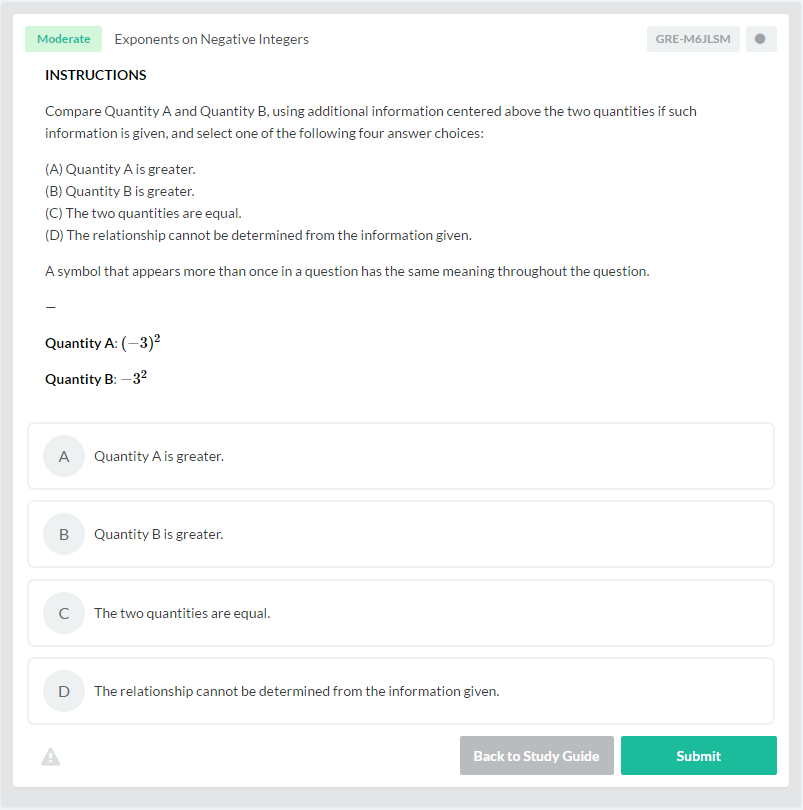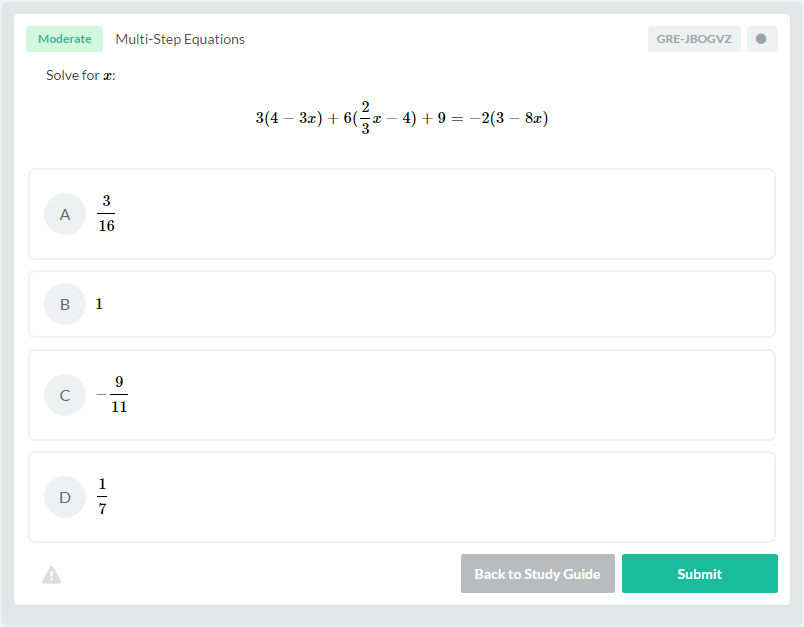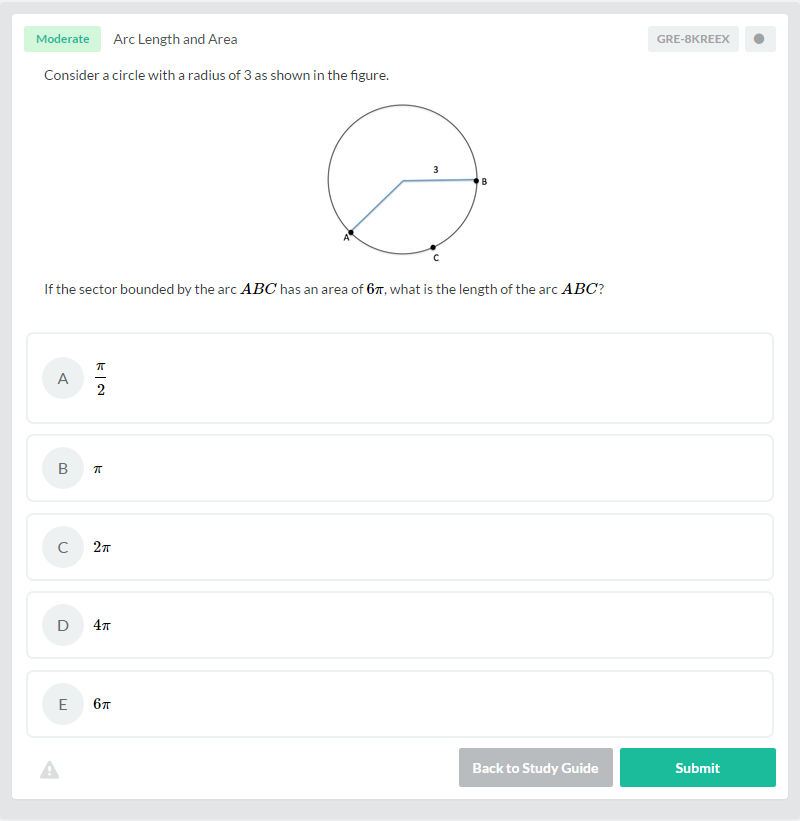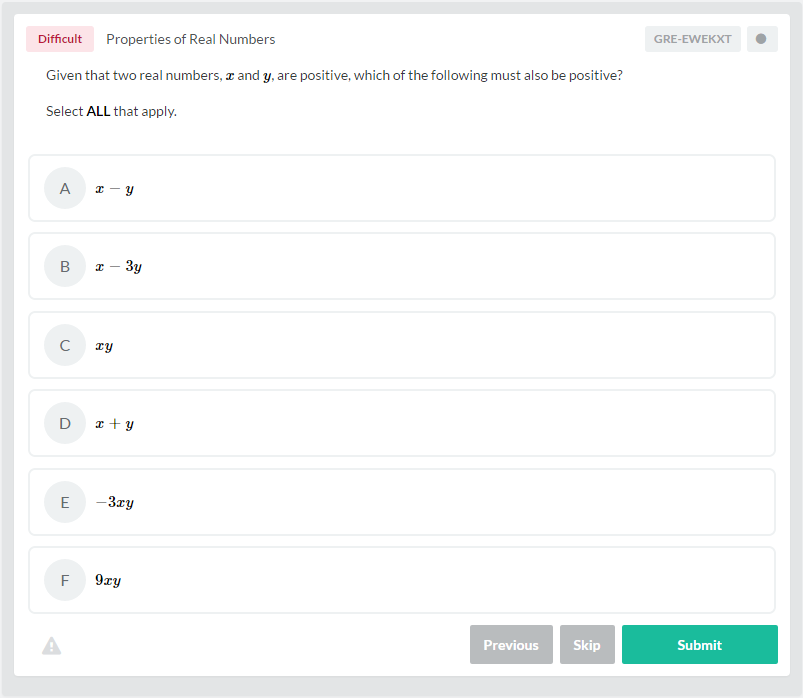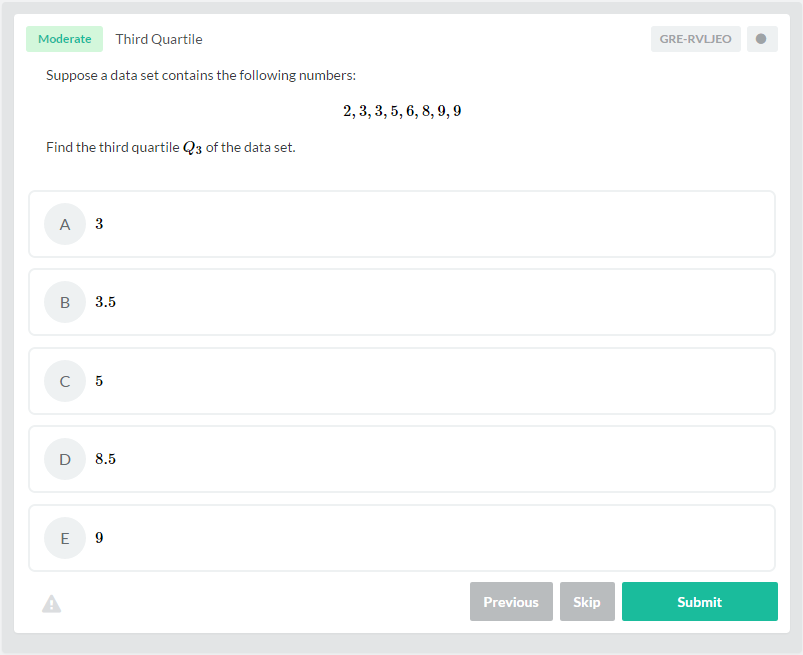The GRE’s Quantitative Reasoning section has a strong emphasis on Math Reasoning and Mathematical problems. The section comprises questions related to Algebra, Arithmetic, Geometry, and Data Analysis. Even though GRE Math does not ask questions about higher order Calculus, it still requires a lot of practice to earn a good score.
The GRE Quantitative Reasoning section’s questions are broadly divided into four subjects:
- Arithmetic: These questions include integers and their properties (divisibility, factorization, prime numbers, etc.), number line, exponents and roots, absolute value, percent, and ratios, etc.
- Algebra: These questions include factoring and simplifying algebraic expressions; relations between different expressions, functions, and equations; solving simultaneous equations and inequalities; and coordinate geometry and its principle concepts such as intercepts, slopes of lines, etc.
- Geometry: These questions are mostly concerned with lines, circles, triangles (including different properties of triangles and types), 3D figures, area, perimeter, volume, fundamental theorems, etc.
- Data Analysis and Representation: Basic statistics (such as mean, median, mode, etc), interpretation of data represented using tables and graphs, bar graphs, circle graphs, box plots, scatter plots, frequency distributions, etc.
The questions in the Quantitative Reasoning section can be presented in four different formats: quantitative comparison questions, multiple choice questions where one answer is correct, multiple-choice questions where one or more answers are correct, and numeric entry questions. The examples given in this article go through these questions and types to better explain them and the basic strategy you can employ while answering them.
In this article, there are seven different GRE Math practice problems arranged roughly in order of difficulty, starting from the easier ones. These are a few examples of the kinds of questions you will be facing for your GRE and are meant as an indicator to help familiarize you with the difficulty and pattern of the questions you will be facing. All of these problems are taken from Albert.io’s GRE practice questions.
GRE Math Practice Questions
Question #1
Starting off with an easy question, this problem requires knowledge of simple arithmetic properties of integers. To answer it, you need to be know divisibility, factors, and factorization. Such questions are often seen in GRE test and can fetch solid marks, but you need to be careful to not make silly mistakes while calculating the answers in your head. This is a single choice answer question; you only have to select one option which you feel is the correct answer.
If you are attempting a single choice answer question and you feel unsure about which option to select, try eliminating the options you believe are wrong. Then between the remaining choices, try evaluating both individually and see if one fits better than the other, and choose that. If you are still not sure, mark the question and leave it for later.
Question #2
Now we’re moving onto some more difficult questions. This is a harder arithmetic problem which focuses on the properties of exponents. It is also a comparison question, one of the four different types of questions prevalent in GRE Math section.
In comparison questions, you are given two quantities (A and B), and you have to tell which one is greater, or if they’re equal, or if that answer cannot be determined from the information presented to you. A crucial point for attempting comparison questions with variables (such as x, y, etc.) is that you should keep in mind all possible values of these variables. Checking for one value of x or y might not be enough. The relation between those values might change for different values, and the answer might be undetermined (option D in the above question).
Question #3
This question is concerned with algebra and more specifically with solving linear equations. It is a single choice answer which requires you to solve the given equation and write the value of z. You can solve such questions using step-by-step simplifications and then choose the answer you are getting. Often, they do not have a quick or easy way of finding the answer and require some work. Practice is necessary if you want to be able to do such questions within the short period allotted to you during the GRE.
Question #4
This question is concerned with geometry and more specifically with circles and their arcs. Geometry is one of the four key areas tested in GRE Math and such questions require you to be familiar with properties of different 2D (such as circle, square, rectangle, triangle, etc.) and 3D shapes (such as sphere, cube, cuboid, etc.). You’ll need to know the formulas for finding different properties such as perimeter, area, and volume.
You should be familiar with the concepts behind these geometrical figures and their formulas. GRE questions are not always straightforward and often require the application of the geometric concepts related to the given figure.
Question #5

Here is a question involving Data Representation. It is a multiple choice question and may have one or more choices as the correct answer. These questions are some of the more difficult ones you will see in the GRE Math section. Their unpredictability regarding number of answers makes them difficult and requires you to be well versed in the question’s domain.
The question itself is concerned with data visualization, with the focus on the frequency distribution. Other Data Representation questions can be related to reading, and interpreting scatterplots, histograms, bar graphs, probability, and similar statistical topics. You must practice the different statistical concepts prevalent in GRE, your ability to read the given visual data and process it quickly, and your ability to draw conclusions from given visual data quickly.
Question #6
This is an arithmetic question, focusing on the properties of real numbers. It is also a multiple answer question and can have anywhere from one to six correct answers. These types are on the difficult side, and the variable number of correct options make them especially tricky to get right.
To be able to answer these questions correctly, you need to be very familiar with properties of real numbers, and other related arithmetic concepts, such as integers, exponents, and ratios.
Question #7
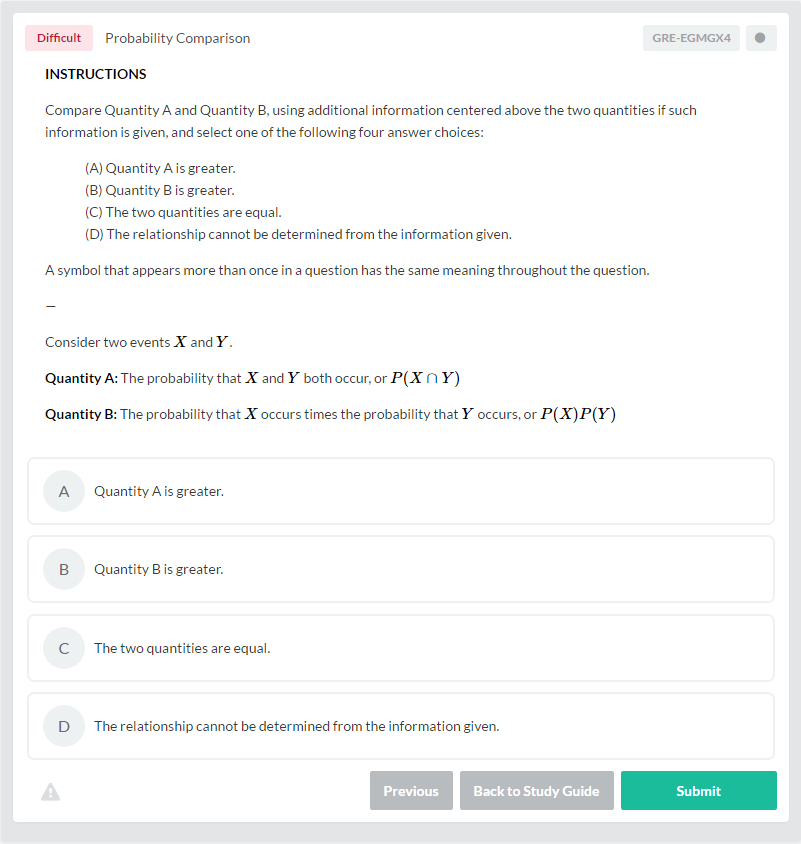
This is a Data Representation problem concerned with probability, which requires you to compare the two given quantities. The problem is difficult because of the level of knowledge required to be able to solve it. It is concerned with fundamental properties of probability, including how two events’ probabilities relate to one another and how one can calculate the probabilities of multiple events occurring simultaneously.
Probability questions, especially the more difficult ones, are concerned with the fundamentals of probability and how they apply to real life scenarios.
How can You be Prepared for GRE Quantitative Reasoning Section?
Preparing for the Quantitative Reasoning section is all about practicing with the right type of questions and understanding the concepts for the topics prevalent in this section. Here are a few tips which can help you do better in the GRE Math section:
- Know the formulas for the problems you will be doing. Practice using those formulas; it’s the best way to learn them. As you practice further, try to rely less and less on looking up the formulas and more on your recall. During the actual GRE, you will not have a lot of time, and you need to be able to recall the relevant formula quickly.
- Practice with genuine GRE practice questions. There are a lot of math books which explain the concepts well and have practice questions; however, these questions are not specifically crafted for GRE. Using materials designed for the GRE gives you the benefit of getting familiar with the test, its format, and the variety of questions you’ll be expected to answer.
- Always remember the importance of time management. Time yourself while practicing and see whether your answer time is within an acceptable threshold or not.
- Albert.io offers several practice questions specifically crafted for GRE Quantitative Reasoning which can be taken by topic or in mixed-topic practice sets. These questions are also presented in order of their difficulty, which helps you gauge your preparation level and find your weak points. Once you feel confident in a topic, you can attempt the questions offered on the website and see how well you can do.
This article discussed through the key topics asked in the GRE Quantitative Reasoning section using a few example questions. The key to doing well for any examination is to have sufficient practice and preparedness, and the GRE is no different.
The GRE Quantitative Reasoning is a purely mathematical section which puts a lot of emphasis on your knowledge mathematical concepts and your ability to apply them. Practicing these concepts and questions will not only increase your accuracy, but also help you clear the section on time. If you would like to improve your GRE Verbal score as well, look at GRE Verbal Practice Questions.
Let’s put everything into practice. Try this GRE practice question:
Looking for more GRE practice?
You can find thousands of practice questions on Albert.io. Albert.io lets you customize your learning experience to target practice where you need the most help. We’ll give you challenging practice questions to help you achieve mastery of the GRE .
Start practicing on here.
Are you a teacher or administrator interested in boosting GRE student outcomes?
Learn more about our school licenses here.


